You can transform everyday household items into powerful garden pest deterrents using simple, eco-friendly methods. Sprinkle coffee grounds around plants to create abrasive barriers that slugs won’t cross, while crushed eggshells form sharp perimeters against soft-bodied pests. Cut plastic bottles into protective cloches for seedlings, hang soap bars to repel deer and rabbits, and use mesh produce bags as breathable shields against flying insects. These creative solutions provide chemical-free protection while turning waste into valuable gardening tools that’ll revolutionize your pest management strategy.
Coffee Grounds Create Natural Slug Barriers
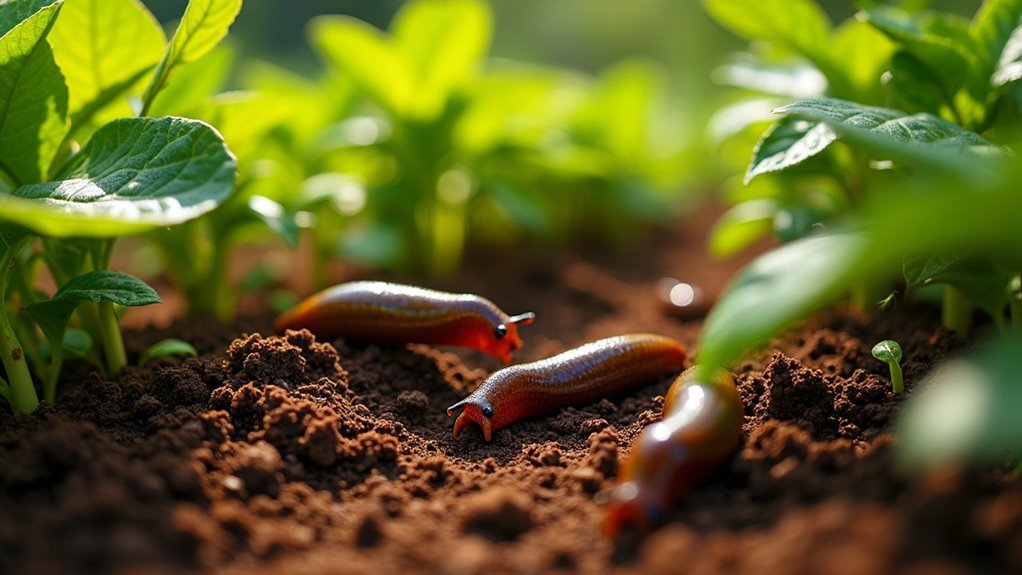
Coffee grounds offer one of the simplest yet most effective ways to protect your plants from slugs and snails.
Used coffee grounds create a natural, chemical-free barrier that effectively repels slugs and snails from your garden plants.
You’ll create an abrasive barrier these pests won’t cross by sprinkling used coffee grounds around vulnerable plants. The acidic texture deters slugs while the caffeine proves toxic to them, reducing their population naturally.
Apply a 1-2 inch layer of coffee grounds around plant bases for maximum effectiveness. This eco-friendly method eliminates the need for harmful chemicals while enriching your soil as the grounds decompose.
You’ll add beneficial nutrients that support plant growth while improving soil drainage and moisture retention.
Coffee grounds provide dual benefits – pest control and soil enhancement – making them an invaluable addition to your organic gardening toolkit.
Eggshells Form Sharp Protective Perimeters
You can transform discarded eggshells into an effective pest deterrent by crushing them and creating sharp protective barriers around your plants.
The jagged edges make it uncomfortable for slugs and soft-bodied pests to cross, while the calcium carbonate slowly breaks down to enrich your soil.
This free solution turns kitchen waste into a dual-purpose garden tool that protects plants and improves soil health without any chemical additives.
Sharp Edges Deter Slugs
While slugs can devastate tender seedlings overnight, crushed eggshells create an effective natural barrier that’ll keep these slimy pests at bay. The sharp edges formed when you crush eggshells create an abrasive texture that injures slugs, making them think twice before crossing into your garden beds.
This slug barrier works by creating physical discomfort that discourages these pests from reaching your vulnerable plants. You’ll need to apply a thick, continuous layer around each plant’s base, ensuring there aren’t any gaps where slugs could sneak through.
As the eggshells decompose, they’ll also enrich your soil with valuable calcium. Studies show this natural, eco-friendly method considerably reduces slug damage while repurposing household waste.
Calcium Enriches Garden Soil
Beyond their pest-deterring properties, eggshells deliver a calcium boost that transforms your garden soil into a nutrient-rich foundation for healthier plants.
When you crush and mix eggshells into your soil, calcium enriches garden soil by improving structure and drainage, creating ideal conditions for root development and nutrient absorption.
This essential mineral strengthens plant cell walls, making your vegetables more resilient against diseases and environmental stress.
You’ll notice particularly dramatic results with tomatoes and peppers, where adequate calcium prevents blossom end rot—a common problem that ruins harvests.
The slow-release nature of calcium from eggshells provides long-term soil benefits while recycling kitchen waste, making this sustainable practice both economical and environmentally responsible for dedicated gardeners.
Free Natural Pest Barrier
Although commercial pest deterrents can drain your gardening budget, crushed eggshells form a formidable defensive line that costs nothing and protects your most vulnerable plants.
This free natural pest barrier creates sharp, abrasive surfaces that discourage soft-bodied invaders like slugs, snails, and cutworms from reaching your delicate seedlings.
You’ll need to thoroughly clean, dry, and crush your eggshells into small pieces before scattering them around small plants’ bases.
As an added bonus, the calcium carbonate enriches your soil while decomposing, supporting healthier plant growth.
Studies show this method reduces pest damage by up to 50%.
Plus, the white shell fragments can enhance your garden decor while repurposing kitchen waste sustainably.
Aluminum Foil Reflects Light to Deter Flying Pests
One of the most accessible and effective pest deterrents hiding in your kitchen drawer is aluminum foil. This shiny household staple creates flashes of light that disorient flying insects like aphids and whiteflies, making your garden an uncomfortable environment for them.
| Pest Type | Effectiveness | Placement Method |
|---|---|---|
| Aphids | Up to 50% reduction | Around plant bases |
| Whiteflies | High deterrence | Flat on soil surface |
| Flying beetles | Moderate success | Hanging strips |
| Thrips | Good results | Reflective mulch |
| Gnats | Variable effects | Strategic positioning |
Position your aluminum foil to catch sunlight throughout the day for maximum light reflection. This non-toxic, eco-friendly method protects beneficial insects while effectively reducing pest presence without chemical repellents.
Plastic Bottles Transform Into Protective Plant Cloches

You’ll find that transforming plastic bottles into protective plant cloches requires just a few simple cuts and modifications to create effective pest barriers.
Cut each bottle in half horizontally, remove the cap or poke ventilation holes in the sides, then place the top portion over your seedlings to shield them from insects and harsh weather.
Regular maintenance involves adjusting the cloche position as plants grow and ensuring adequate airflow to prevent moisture buildup that could harm your plants.
Cutting and Shaping Bottles
Transform ordinary plastic bottles into powerful plant protectors with a few simple cuts that create effective mini greenhouses for your seedlings. Remove the bottom portion of each bottle, leaving the neck and top intact. This creates an open-ended dome that slides easily over young plants.
| Step | Tool Needed | Safety Tip |
|---|---|---|
| Mark cutting line | Permanent marker | Measure 4-6 inches from bottom |
| Cut bottle cleanly | Sharp craft knife | Cut away from your body |
| Smooth rough edges | Sandpaper/file | Prevent plant damage |
| Test fit size | None | guarantee adequate plant clearance |
| Create ventilation | Small drill/nail | Poke holes in sides if needed |
Position the cut plastic bottles over vulnerable seedlings and press firmly into soil. The clear walls allow sunlight penetration while blocking pests and harsh weather.
Installation and Maintenance Tips
After you’ve crafted your bottle cloches, proper installation guarantees maximum protection for your seedlings. Position each cloche over your plants and push the bottom edge into the soil several inches deep for stability against wind. This anchoring method also creates natural drainage holes around the base.
Monitor your cloches throughout the growing season:
- Check temperature regularly – Remove caps or lift cloches entirely on hot days to prevent overheating
- Inspect for damage – Look for cracks or holes that compromise protection
- Ensure proper ventilation – Keep bottle caps removed to maintain air circulation
- Replace when needed – Swap out damaged cloches immediately to maintain continuous plant protection
Regular maintenance keeps your DIY pest barriers functioning effectively all season long.
Soap Bars Repel Deer and Rabbits Naturally
Ordinary soap bars sitting in your bathroom cabinet can become powerful allies in your fight against garden pests. Breaking these soap bars into pieces and hanging them in mesh bags or old nylons around your garden creates an effective barrier against deer and rabbits.
The strong deodorant scent proves particularly offensive to deer, causing them to avoid treated areas entirely.
You’ll maximize effectiveness by positioning soap near prime feeding spots or around your garden’s perimeter. For concentrated protection, grate soap shavings and sprinkle them directly around vulnerable plants.
This natural deterrent method offers an eco-friendly alternative to chemical repellents, reducing your reliance on synthetic substances while protecting your valuable crops and plants from persistent foraging animals.
Copper Pennies Stop Slugs and Snails in Their Tracks
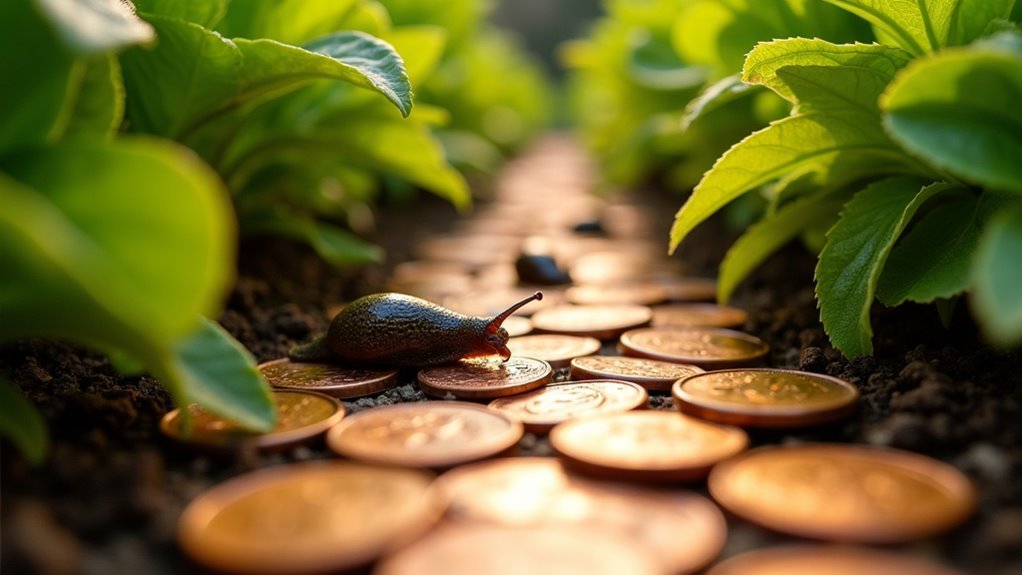
While your loose change might seem worthless for gardening, copper pennies create an ingenious defense system against slugs and snails that’s both effective and budget-friendly.
When moisture hits copper, it generates a small electrical charge that creates a mild shock, disrupting these pests’ movement and feeding behavior. This natural reaction makes copper pennies an excellent eco-friendly alternative to chemical pesticides.
Here’s how to implement this simple solution:
- Place copper pennies directly around plant bases as protective barriers
- Create continuous copper lines across garden bed perimeters
- Space pennies close together for maximum electrical effectiveness
- Replace pennies periodically to maintain their pest-deterrent properties
Studies confirm that copper barriers considerably reduce slug and snail populations while promoting sustainable gardening practices that protect your plants naturally.
Old CDs and DVDs Flash Away Bird Invaders
You can transform old CDs and DVDs into powerful bird deterrents by harnessing their reflective surfaces to create disorienting flashes of light.
The key lies in positioning these discs at varying heights and angles throughout your garden to maximize the light reflection and confuse approaching birds.
When you hang them strategically from different points, the wind-driven movement combined with shifting sunlight creates an unpredictable light show that effectively keeps feathered pests away from your crops.
Maximum Light Reflection Benefits
Brilliance becomes your ally when old CDs and DVDs transform into powerful bird deterrents through their exceptional light-reflecting properties.
These shiny discs create an unpredictable light show that confuses and disorients birds, making your garden beds considerably less appealing to feathered invaders.
Strategic positioning maximizes their reflective potential:
- Varying heights – Hang discs at different elevations to create multiple reflection points
- Multiple angles – Position discs to catch sunlight from various directions throughout the day
- Movement enhancement – Allow gentle swaying to produce dynamic light patterns
- Cluster placement – Group several discs together for intensified visual disruption
Research demonstrates that reflective materials can reduce bird activity by up to 50%.
You’re not just repurposing waste—you’re creating an eco-friendly defense system that protects your plants without harmful chemicals.
Strategic Hanging Placement Tips
Although reflective properties create the foundation for effective bird deterrence, proper placement determines whether your CD and DVD defense system succeeds or fails.
Position these reflective surfaces at varying heights throughout your garden to maximize visibility and startle birds with sudden light changes and movement. Maintain adequate spacing between hanging discs to prevent them from clanking together, which reduces their deterrent effectiveness.
Deploy multiple CDs across different garden areas to create extensive coverage zones that target various bird species.
You’ll achieve better results by combining your reflective disc system with complementary deterrents like wind chimes or motion-activated devices. This multi-layered approach guarantees birds encounter multiple deterrent signals, making your garden less appealing for unwanted feathered visitors seeking easy meals.
Paper Bags Shield Plants From Frost and Insects
When unexpected frost threatens your garden or insects target your prized plants, ordinary paper bags transform into protective shields that’ll save your harvest.
These versatile paper bags offer multiple protection methods:
Paper bags serve as multi-purpose garden defenders, shielding plants from frost damage, pest invasion, and environmental threats with simple placement techniques.
- Frost protection – Place bags upside down over vulnerable plants to trap warm air and shield them from freezing temperatures.
- Secure anchoring – Weight down edges with soil or rocks to keep bags in place throughout cold nights.
- Insect barriers – Cover ripening fruits or delicate seedlings to prevent pest damage.
- Morning removal – Take bags off at sunrise to allow sunlight and proper air circulation.
You’ll prevent moisture buildup that could damage plants while maintaining their health.
Paper bags also double as biodegradable seed starting containers, making them an eco-friendly gardening solution that protects against multiple threats.
Tin Cans Block Cutworms Around Seedlings
Cutworms slice through your tender seedlings at soil level, destroying weeks of careful nurturing in a single night. You can stop these destructive pests using tin cans as protective barriers around vulnerable plants.
Remove both ends from empty tin cans and push them several inches into the soil around each seedling. This creates an impenetrable wall that cutworms can’t cross while allowing proper watering and air circulation.
| Step | Action | Benefit |
|---|---|---|
| 1 | Remove can ends | Creates open tube |
| 2 | Bury 3 inches deep | Forms protective barrier |
| 3 | Add cornmeal outside | Attracts/deters cutworms |
This eco-friendly solution eliminates chemical pesticides while repurposing household waste. The cornmeal enhancement draws cutworms away from your protected seedlings, creating double protection for your garden investment.
Newspaper Layers Smother Weeds and Pest Habitats
While tin cans protect individual seedlings from cutworms, broader pest control requires tackling the problem at ground level.
Newspaper creates an effective barrier that simultaneously addresses weeds and pest habitats throughout your garden beds.
Layer thick sheets of damp newspaper across problem areas to establish extensive ground coverage. This simple technique delivers multiple benefits:
- Blocks sunlight – Prevents weed germination and smothers existing roots
- Deters pests – Creates habitat barriers limiting access to soil and plants
- Requires 5-10 sheets minimum – Thicker layers increase effectiveness against light penetration
- Enriches soil – Decomposes into organic matter enhancing nutrient availability
Anchor your newspaper with rocks or mulch to prevent shifting.
You’ll maintain long-lasting protection while creating a cleaner garden environment that naturally suppresses both weeds and pest populations.
Dryer Sheets Eliminate Aphids and Thrips
Although newspaper provides ground-level pest control, aerial attackers like aphids and thrips require a different defensive strategy. You can repurpose used dryer sheets to create an effective barrier against these flying pests. The chemicals in dryer sheets, including linalool and benzyl acetate, repel insects while their strong scents mask your plants’ natural attracting odors.
| Placement Method | Effectiveness |
|---|---|
| Hang in mesh bags | Reduces pests up to 50% |
| Tie to garden stakes | Creates protective barrier |
| Position near affected plants | Masks plant odors |
| Replace every 2-3 weeks | Maintains repelling power |
Simply hang dryer sheets in mesh bags or tie them to stakes around vulnerable plants. This sustainable method not only controls pest populations but also gives your used dryer sheets a second life in the garden.
Wine Corks Mark Plants While Deterring Rodents
Beyond protecting plants from airborne invaders, you can tackle ground-level rodent problems with an unexpected household item: wine corks.
These versatile cork stoppers serve dual purposes in your garden, functioning as both plant identification tools and natural pest deterrents.
Wine corks offer multiple garden benefits:
- Plant labeling – Write plant names with permanent markers for easy seedling identification
- Scent deterrent – Natural cork odors repel rodents who avoid unfamiliar smells
- Physical barrier – Strategic placement around plant bases disrupts burrowing attempts
- Movement disruption – Cork texture makes navigation challenging for small animals
You’ll create an eco-friendly solution that recycles materials while protecting your plants.
Simply place labeled wine corks around vulnerable areas to establish effective rodent control while maintaining organized garden records.
Mesh Produce Bags Protect Fruits From Flying Insects
Those mesh produce bags from your grocery trips can transform into powerful shields against flying pests threatening your fruit harvest.
You’ll create an effective physical barrier by draping these bags over fruit-bearing plants, preventing fruit flies and aphids from reaching your crops. The breathable material maintains proper air circulation and sunlight penetration, keeping your plants healthy while providing protection.
These reusable mesh produce bags offer a sustainable, chemical-free pest control solution.
You’ll notice considerably reduced infestation risks, leading to higher fruit yields and better quality harvests. Your protected fruit stays cleaner too, requiring less washing since it’s shielded from dirt, insect droppings, and other contaminants.
This simple repurposing method delivers impressive results while supporting environmentally responsible gardening practices.
Frequently Asked Questions
What Is the Best Deterrent for Garden Pests?
You’ll find companion planting works best for deterring garden pests. Plant marigolds, basil, and nasturtiums alongside your crops to naturally repel insects while attracting beneficial predators that’ll maintain your garden’s ecological balance.
What Home Remedy Kills Bugs in a Vegetable Garden?
You’ll find dish soap mixed with water effectively kills soft-bodied bugs like aphids. Mix one tablespoon soap per quart water and spray directly on pests to eliminate them quickly.
How Do You Deter Pests From Your Garden?
You’ll deter pests by installing reflective aluminum pie tins, placing copper tape around beds, planting aromatic lavender and mint, hanging wind chimes, and creating stone cairns for beneficial predators.
How Do I Keep My Vegetable Garden Pest Free?
You’ll keep pests away by installing reflective pinwheels, placing copper tape around beds, planting companion flowers, using motion-activated owl decoys, and covering crops with protective netting for chemical-free garden protection.
In Summary
You’ll save money and reduce waste by giving these common household items a second life in your garden. Don’t throw away coffee grounds, eggshells, or aluminum foil—they’re powerful pest deterrents hiding in plain sight. You’re already equipped with effective, eco-friendly solutions that’ll protect your plants without harsh chemicals. Start collecting these everyday materials now, and you’ll discover that sustainable gardening doesn’t require expensive products or complicated techniques.

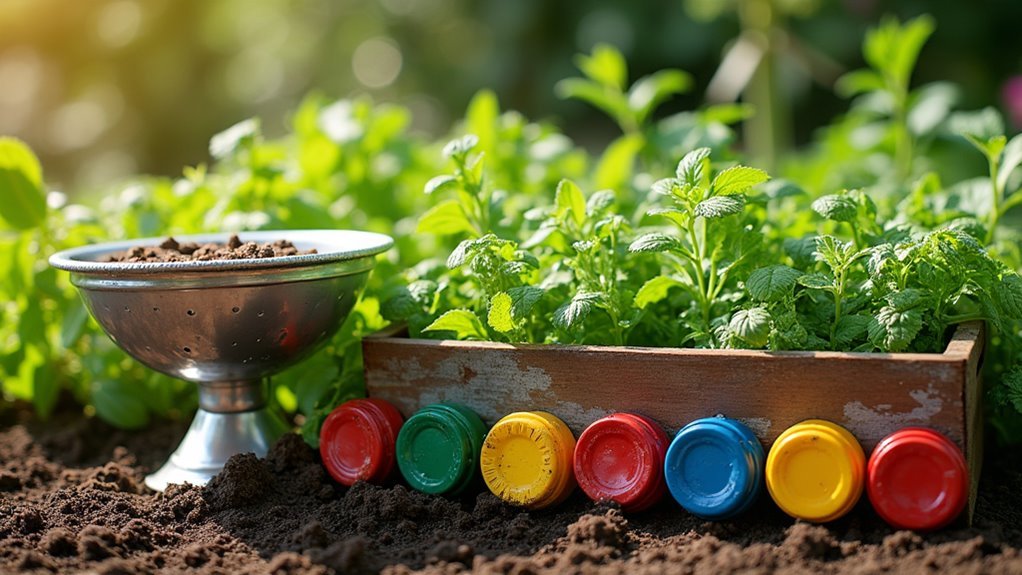
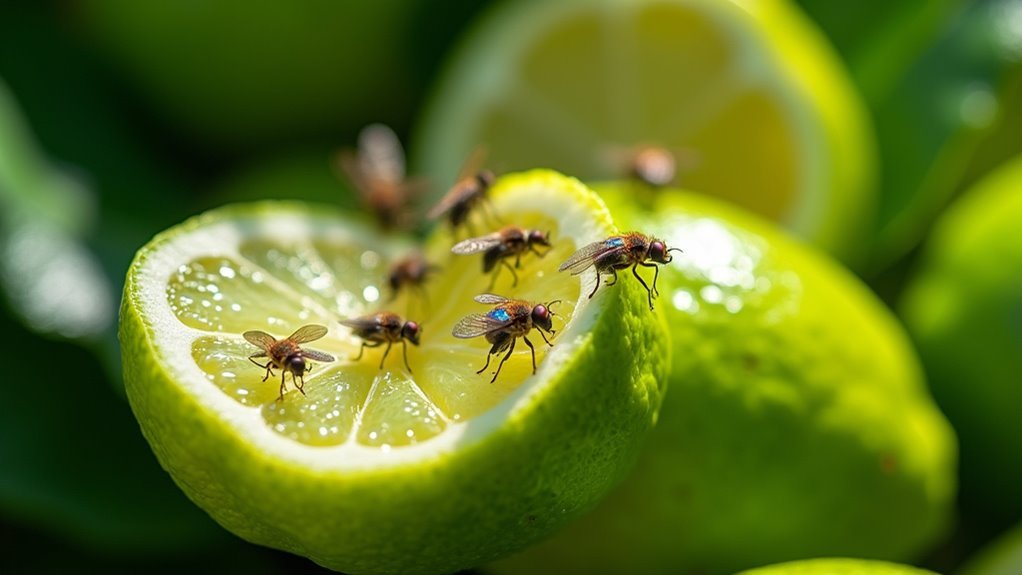

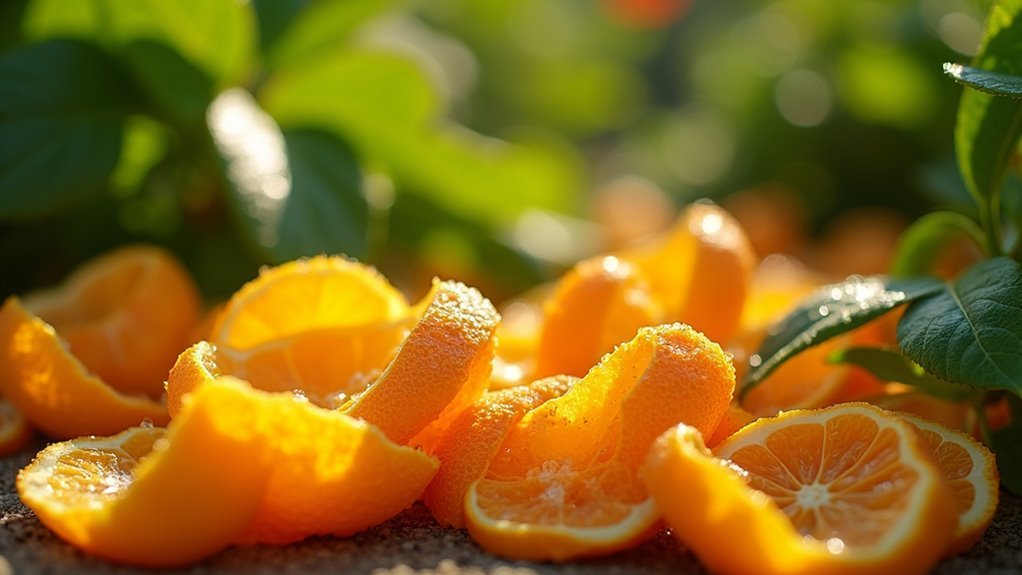
Leave a Reply